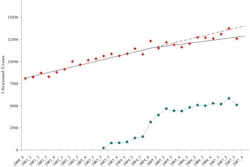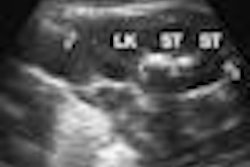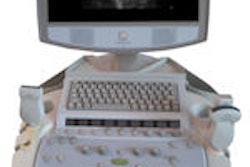British pediatricians at a London children's hospital are using ultrasound to assess the severity of constipation in children. They have found that ultrasound is a good substitute for abdominal x-ray, with its radiation exposure, or a digital rectal examination, a procedure that children find unpleasant and disturbing.
Evelina Children's Hospital in London is a tertiary referral center for patients with chronic constipation. Its specialized intestinal motility team treats children with chronic idiopathic constipation on long-term laxatives, children who have had previous manual evacuations, children with behavioral and developmental problems, and children with pathological constipation and anorectal anomalies.
Dr. Bhanumathi Lakshminarayanan, a pediatric gastrointestinal specialist, and colleagues from Evelina Children's describe a system they developed for scoring ultrasound exams of constipated children in an article published in Pediatric Surgery International (December 2008, Vol. 24, pp. 1379-1384).
According to the study, the scoring system enables pediatricians to accurately measure fecal loading in a consistent manner. It also provides a tool to assess the long-term improvement of patients undergoing treatment for chronic constipation.
The ultrasound exam includes scans done in both the transverse and longitudinal plane 2 cm above the pubic symphysis, with the ultrasound probe held perpendicular to the skin. The presence of feces in the rectum appears as a crescent-shaped acoustic shadow. Stool height is measured by following this shadow cranially until the apex is visualized.
The clinician then marks the stool height as no stool, retro bladder, just above bladder, nearly umbilicus, to umbilicus, beyond umbilicus, or unable to see upper edge. Each of these categories is assigned a consecutive number, from 1 through 7. An uncooperative patient is marked as category 99.
The bladder is then evaluated as empty or no compression (both 0 scores), or as an indented (1), flattened (2), or displaced (3) bladder. The sets of scores are added and used with a standard symptom severity scoring sheet completed by the parent or child and the assessment of a clinical examination.
To test the accuracy of the scoring system, the physicians prospectively collected and evaluated data on 500 children who were treated at the hospital's constipation clinic from January 2007 to July 2008. The group consisted of 317 boys and 183 girls, ranging in age from 8 months to 18 years (median age, 8 years). Fifty-five percent of the patients were seen once, 33% were seen twice, 10% were seen three times, and 2% were seen four times at the clinic.
The authors determined that there was a correlation between the symptom severity and the score, as well as a significant correlation between clinically palpable feces and total ultrasound score.
Benefits
In addition to its ability to show both hard and soft feces, ultrasound can show significant fecal loading in patients for whom no feces was palpable. In this study, abdominal palpation underestimated the degree of fecal loading as judged by ultrasound in 84 patients, or 31%.
For patients requiring follow-up visits, comparing ultrasound scores enables the pediatricians to determine if clinical management is effective. In the study, children with very severe symptoms and fecal impaction either had a change of medical management or underwent anorectal manometry and manual evacuation.
The authors reported that the ultrasound exam has one other major benefit. It helps convince parents and patients that fecal retention is the cause of overflow fecal incontinence, the primary complaint and source of distress for the school-aged patient.
By Cynthia E. Keen
AuntMinnie.com staff writer
April 27, 2009
Related Reading
X-ray's role debated in systematic diagnosis of pediatric constipation, March 17, 2006
Abdominal radiography not useful in constipated children, July 14, 2005
Test predicts ongoing constipation in kids, August 24, 2004
Copyright © 2009 AuntMinnie.com



















